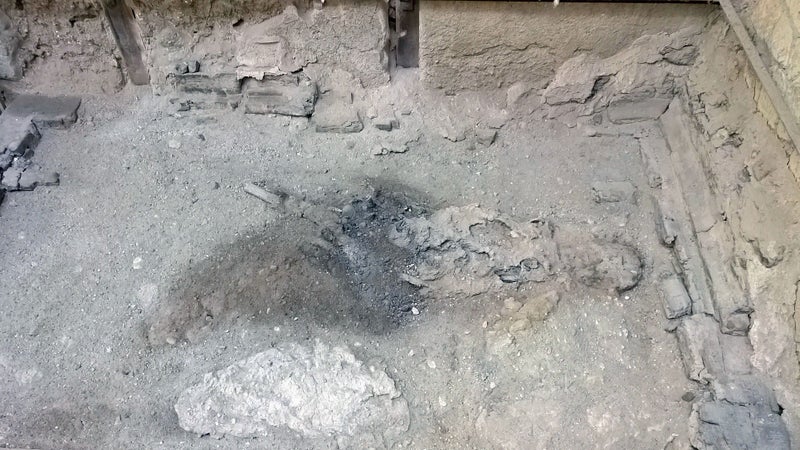A HUNK of dark-coloured glass found inside the skull of an individual who died during the Mount Vesuvius eruption may actually be a fossilised brain, researchers have revealed. Glass rarely forms naturally, due to the very specific and extreme conditions it requires.
![[Aerial view of Pompeii ruins.]](https://www.thesun.co.uk/wp-content/uploads/2025/02/Image-6.jpg?strip=all&w=960)
But the extreme heat from the short-lived ash cloud that swept through the ancient town of Herculaneum in 79CE likely turned the individuals brain to glass, according to a new study. Researchers Dr Guido Giordano and Dr Pier Paola Petrone analysed fragments of glass from inside the skull and spinal cord of the person.
![[Dark-colored rock sample.]](https://www.thesun.co.uk/wp-content/uploads/2025/02/Image-2-3.png?strip=all&w=577)
The victim had been lying on their bed in the Collegium Augustalium when the cloud descended. For the brain to become glass, it must have been heated to above 510°C before quickly cooling. This is unlikely to have occurred when the pyroclastic flow plunged onto the town.
![[Partially unearthed skeletal remains in soil.]](https://www.thesun.co.uk/wp-content/uploads/2025/02/Image-3-2.jpg?strip=all&w=540)
Pyroclastic flow is the plume of hot gas and lava fragments coughed out by the volcano after the initial burst of ash. The temperatures of the pyroclastic current, while boiling, did not top 465°C and would have cooled down over a longer period of time, researchers wrote.
![[????????????????????????????????????]](https://www.thesun.co.uk/wp-content/uploads/2025/02/Image-1-1.jpg?strip=all&w=960)
Instead, they believe that the pyroclastic flow was actually the second deadly event during Vesuvius' eruption. The first was the initial ash-cloud that turned everything black. The cloud would have whipped through towns like Herculaneum and Pompeii, bringing everything in its path to at least 510°C, before passing and allowing scorched towns to cool again.
![[Fragment of vitrified brain.]](https://www.thesun.co.uk/wp-content/uploads/2025/02/110626117_brainvitrifiedfragment_1_petronecopyright2020.jpg?strip=all&w=960)
It's this post-510°C heat, followed a rapid cooling, that is able to turn organic material to glass. The incredibly rare process is called vitrification. The only other piece of glass suspected to be of 'organic origin' was identified in Herculaneum in 2020.
![[Remains found at Vesuvius.]](https://www.thesun.co.uk/wp-content/uploads/2025/02/110620469_remainsfoundvesuvius.jpg?strip=all&w=800)
A glassy, black material was also found inside the skull of a man who was found on a wooden bed, buried by volcanic ash. Analysis of charred wood near the body revealed that the temperatures reached a maximum of 520°C - enough for the vitrification process to occur.
Dr Petrone, a forensic anthropologist at the University of Naples Federico II who also led the 2020 study, said the man was likely killed instantly by the eruption. "The detection of glassy material from the victim's head, of proteins expressed in human brain, and of fatty acids found in human hair indicates the thermally induced preservation of vitrified human brain tissue," the study wrote at the time.































